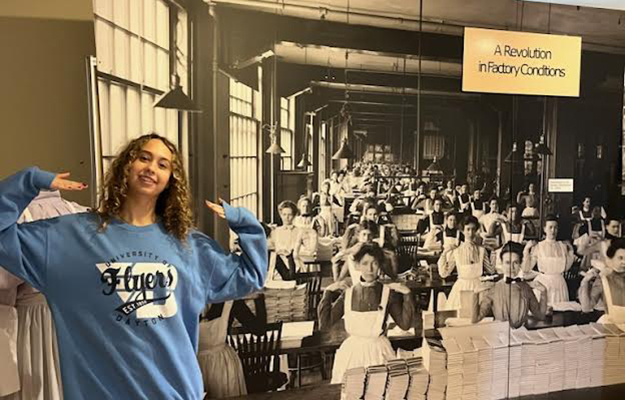Integrated Learning-Living Communities

Business Ethics & Environmental Sustainability: Patterson Homestead guided tour
Until a guided tour of the Patterson Homestead in October 2023, the emphasis of BEES (Business Ethics and Environmental Sustainability integrated living learning community) outings was on environmental sustainability, but the Patterson family provides ample material for a consideration of the other piece of BEES — business ethics.
Despite his celebration as an important early denizen of Dayton, Colonel Robert Patterson (a founder of Lexington, Ky.) was not particularly ethical. In 1805, he was subject to a suit brought by the City of Dayton pertaining to two slaves he brought with him from Kentucky. Patterson had brought the Pages with him from Kentucky to Dayton, Ohio, and claimed that they were indentured servants, not slaves. The court ruled otherwise, and the Pages were set free because Ohio was a free state.
In 1816, Robert Patterson purchased the original property constituting the Rubicon Farm from Daniel C. Cooper, who had built (probably) Dayton’s first grist mill and sawmill on the Rubicon River. This tributary to the Great Miami River now runs under the campus, but the street names (perpendicular to Brown Street — Sawmill and Stonemill) speak to its existence. Later additions to the log cabin (in three phases) rendered the homestead a quintessential example of the Federalist style. And on that farm, Patterson raised hogs, sheep and cattle; grew rye, oats and tobacco; planted an apple orchard and kept bees.
In time, the family farm was transferred to Jefferson and Julia Johnston Jefferson, parents of John H. Patterson, founder of National Cash Register. A later trip to the Johnston Farm and Indian Agency revealed the entangling alliances that knitted the area’s powerful citizens.
John H. Patterson was initially a coal supplier suspicious that his employees (delivery drivers) were absconding with funds. He encountered the ‘incorruptible cashier’ (built by James Ritty to reduce employee theft) in the Pony Saloon, operated by the two Ritty brothers. Patterson liked the machine so much he (and his brother Frank) literally bought the company. In its heyday, the global corporation occupied all the terrain between the UD campus and the river.
John H. Patterson also tangled with the law. According to Wright State University’s special collection archive:
“In February 1912, the United States government filed two suits against National Cash Register under the Sherman Antitrust Act. One was a civil suit against the company itself, and the other sought criminal prosecution of NCR’s president John H. Patterson, vice president Edward A. Deeds, and more than 20 others.
National Cash Register controlled about 95% of the market for cash registers at that time, and the government charged that the company and its leaders were guilty of using unfair, unethical, and downright vicious practices to secure that market share.
On Feb. 13, 1913, the jury of the U.S. District Court in Cincinnati handed down convictions to all but one (and it wasn’t Patterson). Patterson, Deeds, and most of the others were sentenced to fines of $5,000 (plus court costs) each, as well as one year in jail.
Yes, jail. They were as shocked as you are.
They appealed the ruling, of course. Two years later, on March 13, 1915, the Sixth Circuit Court of Appeals overturned the ruling and declared that a new trial would need to be held if the case was to be pursued. It wasn’t, and the matter was dismissed entirely on Feb. 1, 1916.
It is worth noting that in the time between the first conviction, February 1913, and the appeals court ruling in March 1915, Patterson, Deeds, and NCR in general had endeared themselves even more to the Dayton people than perhaps they already were, with their extensive work in flood relief and subsequent flood prevention efforts following the flood that devastated Dayton in March 1913.”
